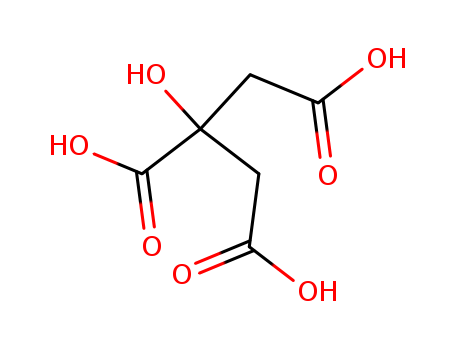Factory supply Citric acid 77-92-9 with sufficient stock and high standard We provide high quality Citric acid (CAS 77-92-9), at a very affordable prices to our customers.
1.What is the Citric acid ?
Citric acid is a white, crystalline, weak organic acid present in most plants and many animals as an intermediate in cellular respiration. Citric acid contains three carboxyl groups making it a carboxylic, more specifically a tricarboxylic, acid.the name citrus originates from the Greek kedromelon meaning apple of melon for the fruit citron. Greek works mention kitron, kitrion, or kitreos for citron fruit, which is an oblong fruit several inches long from the scrublike tree Citrus medica. Lemons and limes have high citric acid content, which may account for up to 8% of the fruit's dry weight.Citric acid is a weak acid and loses hydrogen ions from its three carboxyl groups (COOH) in solution.the loss of a hydrogen ion from each group in the molecule results in the citrate ion,C3H5O(COO)33. A citric acid molecule also forms intermediate ions when one or two hydrogen atoms in the carboxyl groups ionize.the citrate ion combines with metals to form salts, the most common of which is calcium citrate. Citric acid forms esters to produce various citrates, for example trimethyl citrate and triethyl citrate.
Citric Acid is an acidulant and antioxidant produced by mold fermentation of sugar solutions and by extraction from lemon juice, lime juice, and pineapple canning residue. it is the predominant acid in oranges, lemons, and limes. it exists in anhydrous and monohydrate forms. the anhydrous form is crystallized in hot solutions and the monohydrate form is crystallized from cold (below 36.5°c) solutions. anhydrous citric acid has a solubility of 146 g and monohydrate citric acid has a solubility of 175 g/100 ml of distilled water at 20°c. a 1% solution has a ph of 2.3 at 25°c. it is a hygroscopic, strong acid of tart flavor. it is used as an acidulant in fruit drinks and carbonated beverages at 0.25-0.40%, in cheese at 3-4%, and in jellies. it is used as an antioxidant in instant potatoes, wheat chips, and potato sticks, where it prevents spoilage by trapping the metal ions. it is used in combination with antioxidants in the processing of fresh frozen fruits to prevent discoloration.
2.What is the CAS number for Citric acid ?
The CAS number of Citric acid is 77-92-9.
More information of Citric acid 77-92-9 are:
|
CAS Number
|
77-92-9 |
|
Density
|
1.762 g/cm3 |
|
Melting Point
|
153-159 °C(lit.) |
|
Boiling Point
|
309.567 °C at 760 mmHg |
|
Flash Point
|
155.243 °C |
|
Vapor Pressure
|
5.73E-05mmHg at 25°C |
|
Refractive Index
|
1.493~1.509 |
|
HS CODE
|
2918.14
Oral rat LD50: 3000 mg/kg |
|
PSA
|
132.13000 |
|
LogP
|
-1.24850 |
|
Pka
|
3.14(at 20℃) |
3.What is the molecular formula of Citric acid ?
The chemical formula of Citric acid is C6H8O7 which containing 6 Carbon atoms,8 Hydrogen atoms and 7 Oxygen atoms,and the molecular weight, and the molecular weight of Citric acid is 193.117
4.What is Citric acid(77-92-9)used for?
Citric acid is a white, crystalline, weak organic acid present in most plants and many animals as an intermediate in cellular respiration. Citric acid contains three carboxyl groups making it a carboxylic, more specifically a tricarboxylic, acid.the name citrus originates from the Greek kedromelon meaning apple of melon for the fruit citron. Greek works mention kitron, kitrion, or kitreos for citron fruit, which is an oblong fruit several inches long from the scrublike tree Citrus medica. Lemons and limes have high citric acid content, which may account for up to 8% of the fruit's dry weight.Citric acid is a weak acid and loses hydrogen ions from its three carboxyl groups (COOH) in solution.the loss of a hydrogen ion from each group in the molecule results in the citrate ion,C3H5O(COO)33. A citric acid molecule also forms intermediate ions when one or two hydrogen atoms in the carboxyl groups ionize.the citrate ion combines with metals to form salts, the most common of which is calcium citrate. Citric acid forms esters to produce various citrates, for example trimethyl citrate and triethyl citrate.
InChI:InChI=1/C6H8O7/c7-3(8)1-6(13,5(11)12)2-4(9)10/h13H,1-2H2,(H,7,8)(H,9,10)(H,11,12)/p-3
Relevant articles related to Citric acid:
|
Article
|
Source
|
|
-
|
Warneford,Hardy
, (1926)
|
|
SYNTHESIS OF 4-(HYDROXYMETHYL)TETRAHYDRO-4-PYRANOL - A NEW INTERMEDIATE FOR THE PREPARATION OF SYNTHETIC CITRIC ACID
|
Gevorkyan, A. A.,Kazaryan, P. I.,Sargysyan, M. S.,Petrosyan, K. A.,Mkrtumyan, S. A.
, p. 712 - 713 (1983)
|
5.Factory supply Citric acid 77-92-9 with sufficient stock and high standard
Jilin Tianyun New Materials Co., Ltd is a quality supplier of Citric acid. Our main goal is customer satisfaction. Contact us to negotiate the best price for your business on Citric acid 77-92-9.

